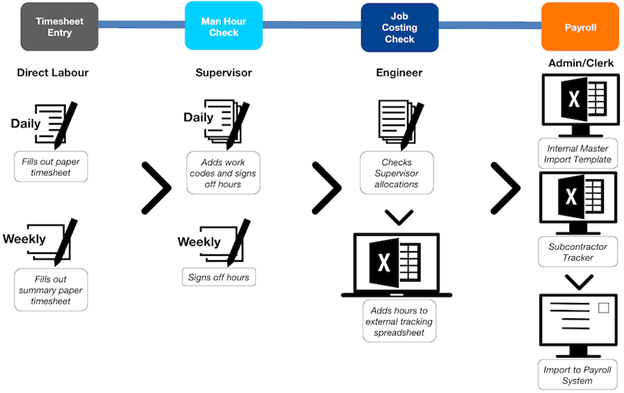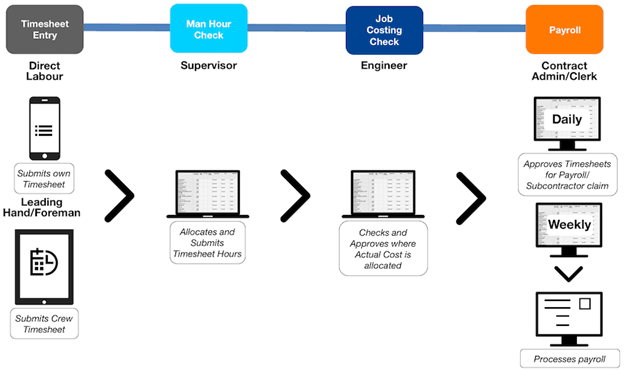Virtuosity Blog
Construction Timesheets 101: Why They’re Critical for Project Success
Why are timesheets so important in construction projects? Should you be using timesheets in your construction projects?
Construction teams are seeing significant dividends from digitizing their construction timesheets. The more we talk with a range of project and business stakeholders across the construction industry, the more we are seeing this process as a huge potential area of improvement and growth for project teams. Given that some of the people who influence decisions around technology adoption may not necessarily have frontline experience, we built a summary of construction timesheet fundamentals to help build a baseline of understanding...
The Benefits of Digitizing Construction Timesheets
Time clocks and attendance records perform several functions on a job site, such as recording when specific people arrive and leave. Depending on the process, construction teams might record who is always on site. For example, they may track entry and exit rather than record who clocked on or off. Start and end times generated also may not be the same as a person’s start and end time for payroll; for example, you might arrive 15 minutes before your scheduled start from which you will be paid.
Timesheets, in contrast, record the quantum of work performed against a specific job or costed activity. They are normally used to drive payroll, as well as job costing and performance reports. Both have distinct roles and, when they are both being effectively used, can be a powerful tool to cross-reference and identify errors. For example, teams can catch missing timesheets and incorrectly recorded timesheets, as well as verify actions such as payroll and subcontract payments.
The approach to capturing time from a contractor’s perspective depends on the contract type and delivery model. Timesheets are generally required for staff, direct workforces, labor hire, and plant and labor workers on day dockets. For example, if a project’s delivery model is under a lump sum contract it may change if a project presents considerable risk exposure to the contractor or client if schedule completion milestones are missed. An example is on large oil and gas and mining projects, where the cost of missed production is high. It’s critical to match timesheet processes, and the level of detail captured, to each project’s contract type and delivery model, to better measure success of a project.
What Roles Require Construction Timesheet Data
There are many stakeholders involved in the time sheeting process and/or who typically use timesheet data. Some of these stakeholders include:
Individual workers – Need a record for payment and a fast, simple process.
Subcontractors – Need a record of their workers’ time to pay them and submit end-of-month progress claims, as well as need easy access and reliable records to ensure payment.
Supervisors – Check and approve hours worked, ensure costs are allocated to the right activities, get feedback on their team’s performance, maximize their field time to keep their project on track, ensure their people get paid, and avoid inventory resource .
Engineers – Approve the allocation of costs to the right activities, monitor performance across their scope, and forecast job costs based on past performance and forward projections.
Project Managers – Monitor scope performance, ask questions on exceptions, and guide corrective actions to keep the project on track.
Payroll – Track leave and pay staff and workforce their entitlements and allowances.
Contracts administrators – Verify subcontractor progress claims, approve appropriate payments, and determine accrued costs that have not hit the finance system.
Chief Financial Officer – Ensure accountability and certainty around who is getting paid what, as well as have an appropriate audit trail to drive verification and responsibility.
Health and Safety Executives (HSE) – Track safety exposure hours worked and safety performance statistics.
Commercial – Require quantified and verified records to substantiate claims for variations and extensions of time.
Project controls – Require quantified records for performance reporting.
Estimators – Require quantified records of time required to perform various activities for comparison against estimating norms to improve competitive estimating on future jobs.
With these fundamentals in mind, manual processes present major risks to projects and leak a significant amount of value either lost time to perform value-adding tasks or avoidable costs.
Below is the core difference between typical manual processes and digital processes:


Why Paper Is Dead in Construction Projects
Paper can seem very forgiving, with minimal validation rules and a human to interpret records. However, it is inefficient, and mistakes are costly. Paper documents can get lost, contain information that is inaccurate or incomplete, and is prone to human error.
Successful adoption of a digital process requires solid upfront thinking and a simple, intuitive solution that is fast for all stakeholders to use. Then, it can remove the need for duplicate timesheet records held in disconnected systems by those diverse stakeholders. Project performance is directly influenced by the efficiency and reliability of its most basic system - timesheets - so setting up this system properly is crucial to project strategy and project success.
------------
Bentley’s SYNCHRO offers a simplified portfolio of digital solutions for construction teams to meet project needs and deliver successful heavy civil projects. Curious to learn more?

